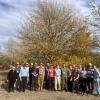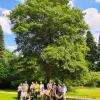Editor's Picks
Plant Focus
The website www.bomengids.nl was founded by ecologist Hans-Cees Speel in October 2003. His professional work is in IT rather than ecology, so Hans-Cees wanted to increase his tree and plant knowledge. But at that time there were no decent tree sites about European trees. So being an ecologist and IT-person, he started his own website, at that time on a home server.
For many years his tree website was at the top of the rankings on Google and in 2010 there were 10 million hits: in those days Wikipedia and other big sites didn't have many reliable tree photos or only a few. Bomengids (“tree guide” in Dutch) had hundreds of detailed pictures and usually several dozen images per species. Here you can browse through 200+ European tree species. And you can browse using 5 languages: Spanish, French, English, German, and of course Dutch.

Hans-Cees’ view on determining tree species has always been non-standard. He published many photos per species, since in reality trees of the same species are not all alike and leaves can have an enormous amount of variety. As an ecologist it's also easy to recognize many natural trees are hybrids and show a mix of features of several species.
Aside from including a large number of photos per species, Bomengids also features a key to identify trees by elimination, Sherlock Holmes–style.

The identification key allows laypeople to recognize species by easy features first: so you don’t have to recognize a birch by its leaves, but seeing the white bark leads you directly to the birch family. Other easy clues are the fruit of tree species, or where they stand. As you can see, this key could use some brushing up and in terms of formatting (a new project).

In 2023 Hans-Cees took the time to gather all oak pictures taken over 20 years on holiday and in his own country, the Netherlands, both in the wild and in street plantings. So among photos of Pyrenean oaks (Quercus pyrenaica), for instance, you don’t only see trees in an arboretum, but also many photos in the forests where they naturally grow. These photos are supplemented by photos from arboreta, both in the USA and Europe. Oh, and also some photos from his garden, where new oaks are grown from acorns, because that’s often the best way to get pictures from small plants in several stages of growth.
The result is a page featuring 64 oak taxa from around the world. You can filter the species by region, if you click on the buttons at the top. If you click on the photos once you will get a full-screen view, where you can once again find links (in blue, below) to the species pages. These sometimes have up to 100 pictures, but alas also sometimes only two or three, depending on the opportunities Hans-Cees found to photograph it. See if you can spot your own arboretum if you work at Kew, San Francisco, an arboretum in Paris, in The Hague, in Switzerland, and so on.
Photos of acorns sown at home (click on the images to access the series of photos on the site)
All images © Hans-Cees Speel



















